Archive:European Neighbourhood Policy - South - transport statistics
Data extracted in June 2021.
Planned article update: March 2022.
Highlights
In 2019, Israel had the highest motorisation rate among European Neighbourhood Policy South countries, with 347 passenger cars per 1 000 inhabitants, compared with 540 per 1 000 inhabitants in the EU.
The largest decrease in recent years in the number of road deaths in the European Neighbourhood Policy-South countries was observed in Egypt, down 58.3 % between 2009 and 2019.
Motorisation rate, 2009 and 2019
This article is part of an online publication; it presents information on a range of transport statistics for the European Union (EU) and 8 of the 10 countries that form the European Neighbourhood Policy-South (ENP-South) region — Algeria, Egypt, Israel, Jordan, Lebanon, Morocco, Palestine [1] and Tunisia; no recent data available for Libya or Syria. It presents information covering transport infrastructure as well as passenger and freight transport for four different modes of transport: road, rail, air and maritime.
Full article
Road transport
Table 1 measures the density of the road transport network in relation to total area, an indicator that is comparable between territories. In 2019, Israel recorded the highest road density (all roads, including motorways) among the ENP-South countries, with 903.7 m of road per square kilometre (km2) of land area. Lebanon and Palestine followed with 655.4 m per km2 and 574.4 m per km2. In Egypt and Tunisia roads were spread more thinly at 182.7 m per km2 and 120.4 m per km2 of total area respectively. In Jordan and Morocco, the latest available data (2018) recorded similar densities of road network, with 83.9 m per km2 and 83.2 m per km2 respectively. The lowest road network density in the ENP-South countries was found in Algeria, with 54.4 m per km2 (2018 data). For comparison, the EU had a density road network estimated at 850.0 m per km2, which was lower than Israel.
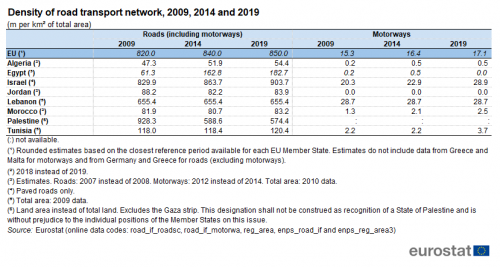
(m per km² of total area)
Source: Eurostat (road_if_roadsc), (road_if_motorwa), (reg_area), (enps_road_if) and (enps_reg_area3)
Among the ENP-South countries, car ownership is usually less commonplace than in the EU and cars tend to account for a lower share of the total number of road vehicles. Subject to data availability, Table 2 shows that Algeria had the highest total number of passenger cars among the ENP-South countries, at 4.2 million in 2018, followed by Israel and Morocco (both 3.1 million in 2019). Tunisia (2019 data) and Jordan (2018 data) reported 1.3 and 1.4 million passenger cars, respectively. Palestine had a significantly lower level than the other countries with 236 thousand passenger cars. Lebanon’s 2019 data for passenger cars was not available, but its 2014 level was 1.5 million, while Egypt had no data on passenger cars.
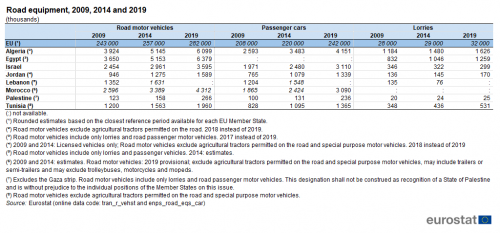
(thousands)
Source: Eurostat (tran_r_vehst) and (enps_road_eqs_car)
In 2019, passenger cars accounted for 89 %, 87 % and 84 % of road motor vehicles in Palestine, Israel and Jordan, respectively. In Tunisia and Morocco they represented 70 % and 72 % of motor vehicles present on roads, respectively, while it was 68 % in Algeria. In 2014, the share of passenger cars in the total number of road motor vehicles was the highest in Palestine among the ENP-South countries, with 95 %. In comparison, the EU’s share was estimated to be around 86 % in 2019, with 242 million cars out of 282 million road motor vehicles.
The remaining of the road motor vehicles were lorries. Algeria had the highest number of them, with 1.6 million in 2018, followed by Egypt (1.3 million – 2017 data). In the other ENP-South countries, with recent data available, the number of lorries were 531 thousand in Tunisia, 299 thousand in Israel, 170 thousand in Jordan (2018 data) and 25 thousand in Palestine. In the EU, lorries accounted for 32 million.
The motorisation rate is measured as the number of passenger cars per 1 000 inhabitants. As shown in Figure 1, among the ENP-South countries, Israel had the highest motorisation rate in 2019 (subject to data availability), at 347 passenger cars per 1 000 inhabitants. This was significantly higher than the next highest motorisation rates, 133 passenger cars per 1 000 inhabitants in Jordan (2018 data) and 118 passenger cars per 1 000 inhabitants in Tunisia (2018 data). Algeria and Morocco respectively had 98 (2018 data) and 87 passenger cars per 1 000 inhabitants. The lowest motorisation rates among the ENP-South countries were found in Palestine and Egypt, respectively, 48 and 32 (2017 data) passengers cars per 1 000 inhabitants. Lebanon’s data was not available for 2019 but had 318 passenger cars per 1 000 inhabitants in 2009.
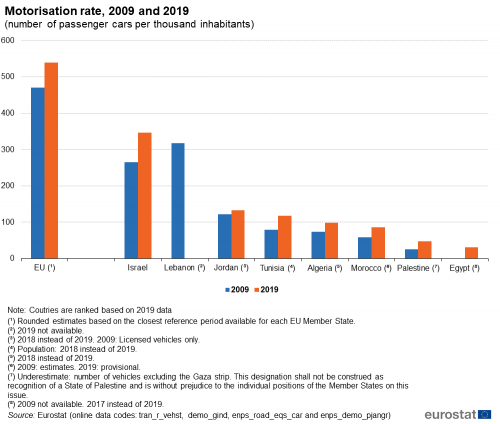
(number of passenger cars per thousand inhabitants)
Source: Eurostat (tran_r_vehst), (demo_gind), (enps_road_eqs_car) and (enps_demo_pjangr)
During the 10-year period 2009-2019, the motorisation rate increased in all ENP-South countries. The ENP-South country with the lowest motorisation rate in 2019 - Palestine – recorded the fastest expansion in car ownership between 2009 and 2019, with a 85.1 % increase. Over the same period, Tunisia and Morocco increased by 49.0 % and 48.0 % respectively. In Algeria (between 2009 and 2018) and Israel, the increases were by 33.5 % and 30.5 % respectively. The lowest growth was found in Jordan, with 9.6 % between 2009 and 2018.
In the EU, there were an estimated 540 passenger cars per 1 000 inhabitants. This marked an increase of 14.8 % in car ownership between 2009 and 2019, or 70 additional cars per 1 000 inhabitants.
Figure 2 presents information on the number of persons killed in road accidents per 100 000 inhabitants for 2009 and 2019. Lebanon was the only country to report an increase in the rate of road fatalities, from 10.0 road fatalities per 100 000 inhabitants in 2009 to 10.3 fatalities per 100 000 inhabitants in 2018. The latter rate was also the highest found in the ENP-South countries. The second highest rate of road fatalities was recorded in Tunisia (10.0 per 100 000 inhabitants - 2018 data). However, there was a 24.7 % decrease from their 2009 rate of 13.2 per 100 000 inhabitants. Morocco and Algeria (2018 data) also had rather high rates of 9.5 and 7.9 fatalities per 100 000 inhabitants respectively. Morocco’s road fatalities rate declined by 25.2 %, while Algeria’s drastically dropped by 40.1 % (between 2009 and 2018). In Jordan, 5.7 per 100 000 persons per 100 000 inhabitants were killed in road accidents in 2018, down from 10.7 in 2009, representing a 47.1 % decline. Israel’s road accident fatality rate declined in 2019 to reach 4.0 persons per 100 000 inhabitants in comparison to 4.7 in 2009 (down 15.1 % ). The highest fall in road fatality rate was found in Egypt, where 3.6 persons per 100 000 inhabitants were killed in road accidents in 2019, compared to 8.5 fatalities per 100 000 inhabitants in 2009; which results in a remarkable 58.3 % over a 10-year period. Palestine’s rate in 2019 was 2.5 persons per 100 000 inhabitants, a decline of 23.1 % from the rate of 3.2 persons per 100 000 inhabitants observed in 2009.
In the EU, the number of persons killed in road accidents per 100 000 inhabitants for 2009 and 2019 were 7.5 and 5.1 respectively, resulting in a decline of 32.0 %.
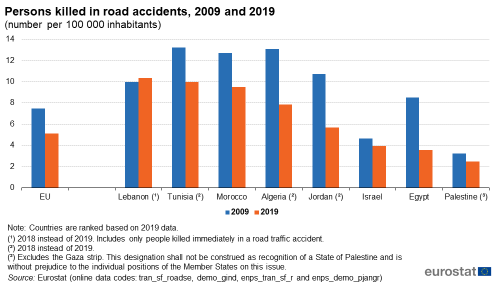
(number per 100 000 inhabitants)
Source: Eurostat (tran_sf_roadse), (demo_gind), (enps_tran_sf_r) and (enps_demo_pjangr)
Rail transport
Passenger-kilometres (pkm) and tonne-kilometres (tonne-km or tkm) are also used for analysing transport statistics. Table 3 shows rail passenger and rail freight transport measured in million passenger-kilometres and million tonnes-kilometres respectively. The majority of passenger and freight transport statistics are based on movements in each of the reporting country, regardless of the nationality of the vehicle or vessel involved (the “territoriality principle”). A rail passenger is any person, excluding members of the train crew, who makes a journey by rail. The weight of goods transported by rail is the gross-gross weight. This includes the total weight of the goods, all packaging, and the tare weight of the container, swap-body and pallets containing goods; in this case of rail freight transport, it also includes road goods vehicles that are carried by rail. The rail passenger and rail freight transport data was not applicable for Lebanon and Palestine.
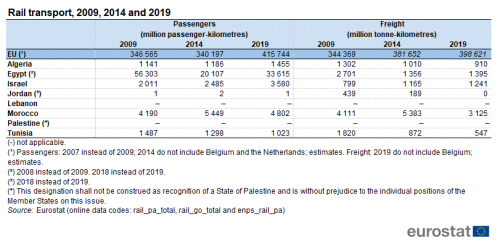
Source: Eurostat (rail_pa_total), (rail_go_total) and (enps_rail_pa)
In Egypt, rail passenger transport in 2018 (no data available for 2019) accounted for 33.6 billion passenger-kilometres, the highest level among the ENP-South countries, but significantly lower than a decade earlier when it was 56.3 billion passenger-kilometres. In Morocco, rail passenger transport increased from 4.2 billion passenger-kilometres in 2009 to 4.8 billion passenger-kilometres in 2019. In Israel, there was 3.6 billion passenger-kilometres in 2019, up from 2.0 billion passenger-kilometres in 2009. In Algeria, rail passenger transport accounted for 1.4 billion passenger-kilometres in 2019; a decade earlier, it was 1.5 billion passenger-kilometres. Tunisia’s rail passenger transport fell to 1.0 billion in 2019 from 1.5 billion passenger-kilometres in 2009. In Jordan, rail passenger transport was considerably lower than in the other ENP-South countries, with 1 million passenger-kilometres in 2018 (no data available for 2019) and similar levels in 2009. In the EU, rail transport accounted for 415.7 million passenger-kilometres in 2019, up from 346.6 million in 2007 (no data available for 2009).
When looking at rail freight transport, Morocco registered 3.1 billion tonne-kilometres in 2019, down from 4.1 billion tonne-kilometres in 2009. Rail freight transport in Egypt accounted for 1.4 billion tonne-kilometres in 2018 (no data available for 2019), when it was 2.7 billion tonne-kilometres in 2008 (no data available for 2009). In Israel, the levels were at 1.2 billion tonne-kilometres in 2019, almost halving compared to 2009, when there were 2.7 billion tonne-kilometres. In Algeria rail freight transport went from 1.3 billion tonne-kilometres in 2009 to 0.9 billion in 2009. Furthermore, Tunisian rail freight transport was divided by more than three between 2009 and 2019; from 1.8 billion tonne-kilometres in 2009 to 0.6 billion tonne-kilometres in 2019. In Jordan, rail freight transport ceased operating in 2018 and is currently in a transitional period. In 2009, there were 439 million tonne-kilometres. In the EU, rail freight transport increased from 344.3 billion tonne-kilometres in 2009 to 398.6 billion tonne-kilometres in 2019.
Air transport
Air transport statistics concern national and international transport, as measured by the number of passengers carried; information is collected for arrivals and departures. There has been a considerable expansion in air services in recent decades, both in terms of passenger numbers and freight carried. Although there has been rapid growth, it is worth noting that the weight of goods carried by air remains relatively low, given the high cost of this mode of transport (for example, when compared with maritime freight) especially for bulky items. Figure 3 shows the amount of passengers arrivals carried by air transport. All passengers on a particular flight (with one flight number) counted once only and not repeatedly on each individual stage of that flight. All revenue and non-revenue passengers whose journey begins or terminates at the reporting airport and transfer passengers joining or leaving the flight at the reporting airport. This measure excludes direct transit passengers.
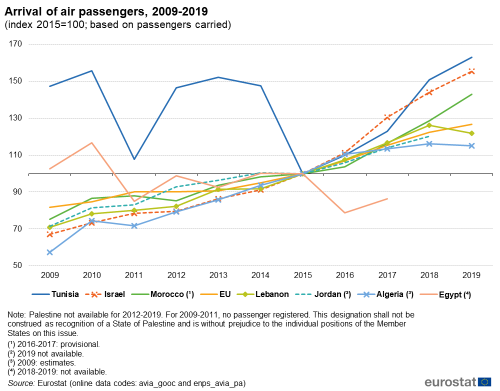
(index 2015=100; based on passengers carried)
Source: Eurostat (avia_gooc) and (enps_avia_pa)
Steady growth of air passenger arrivals was observed for most of the ENP-South countries during the period 2009 to 2019, with the exception of Egypt and Tunisia where the evolution was more erratic. In particular, a substantial drop was observed in 2011 in both countries, as a consequence of the Arabic Spring. In addition, another large decrease was registered in Tunisia in 2015. The terrorist attack close to Sousse in June 2015 was probably a contributing factor. There was a full recovery of the air passenger transport in Tunisia which registered a peak in the number of arrivals in 2019 and a 10.6 % increase compared to 2009. In contrast, in 2017 (no more recent data available), Egypt had still not come back to the levels observed in 2009, with a fall of -15.8 % between 2017 and 2009. Egypt was the only ENP-South country to register a fall over the decade. Israel recorded the highest increase between 2009 and 2019, with the number of air passenger arrivals that more than doubled, from 5.3 million passengers in 2009 to 12.2 million in 2019. In Algeria, the number of air passenger arrivals doubled over the period considered, from 3.6 million passengers in 2009 to 7.2 thousand in 2019. The number of arrivals of air passengers in Morocco grew by 90.3 %, to 12.4 million passengers in 2019 compared to 6.5 million a decade earlier. Lebanon and Jordan arrivals increased at a similar path (71.7 % and 68.4 % respectively), with a number of air passengers that went from 2.5 and 2.6 million in 2009 respectively to both 4.3 million in 2019 (2018 for Jordan). There is no data available for Palestine for the period 2012-2019 and no passengers were registered in the period 2009-2011. In the EU, arrivals of air passenger numbers increased by 55.1 %, between 2009 and 2019, from 486.7 million in 2009 to 754.7 million in 2019.
Figure 4 presents the evolution of air transport of freight and mail, i.e. loaded and unloaded in the airports of the reporting country, between 2009 and 2019. Among the ENP-South countries, the quantity of air freight and mail transported was the highest in Israel, reaching 305.8 thousand tonnes in 2019. Egypt recorded the second highest quantity of air freight and mail, at 320.7 thousand tonnes in 2017 (most recent data available). Jordan followed with 108.2 thousand tonnes air freight and mail transported in 2018 (no 2019 data available). Morocco reported 96.1 thousand tonnes of air freight and mail transported in 2019, Lebanon 87.5 thousand tonnes. In the same year, Algeria’s numbers were half as small, with 43.6 thousand tonnes. Finally, Tunisia had the smallest quantity of air freight and mail transported with 28.5 thousand tonnes in 2019. There is no data available for Palestine. In comparison, there were 13.9 billion tonnes loaded and unloaded in EU airports in 2019.

(index 2015=100; based on tonnes on board)
Source: Eurostat (avia_gooc) and (enps_avia_fr)
Between 2009 (2015 for Lebanon) and 2019 (2017 Egypt for and 2018 for Jordan), the quantity of air freight and mail increased in all ENP-South countries for which data are available, except for Lebanon where it fell by 4.2 % between 2015 and 2019. Egyptian and Tunisian air transport increased by 10.6 % and 16.8 % respectively. In Jordan and Israel, air transported freight and mail rose by 29.3 % and 28.5 %, respectively, between 2009 and 2019 (2018 for Jordan). In Algeria there was a growth of 52.6 % while Morocco reported the highest increase of all the ENP-South countries, with 63.8 % between 2009 and 2019. As a comparison, the EU experienced a growth of 40.5 % in air transport of freight and mail.
Maritime transport
Figure 5 provides information on the number of maritime passengers that disembarked in each of the ENP-South countries. A sea passenger is defined as any person that makes a sea journey on a merchant ship; service staff are excluded, as are non-fare paying crew members travelling but not assigned, as well as infants in arms.
Among the ENP-South countries, the number of maritime passengers disembarked was by far the highest in Morocco, reaching 2.6 million tonnes in 2019. Egypt recorded the second highest number of maritime passengers disembarked, at 0.5 million passengers in 2015 (more recent data not available). Tunisia and Algeria followed with 0.4 million passengers disembarked each in 2019. Israel and Jordan reported each 0.1 million passengers disembarked in 2019 (2018 data for Jordan). Finally, Tunisia had the smallest number of maritime passengers disembarked with 8 thousand in 2019. There is no data available for Palestine. In comparison, there were 201.5 million passengers disembarked in EU ports in 2019.
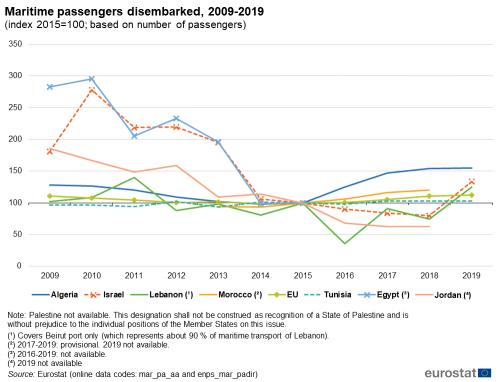
(index 2015=100; based on number of passengers)
Source: Eurostat (mar_pa_aa) and (enps_mar_padir)
Between 2013 and 2018 (no data available before 2013 and in 2019), Morocco registered a growth by 27.9 % in the number of maritime passengers disembarked in its ports. Between 2009 and 2019, Lebanon and Algeria recorded a positive change by 22.2 % and 21.2 % respectively. It should be noted that Lebanese data only refer to the port of Beirut which represents about 90 % of maritime transport of Lebanon. Tunisia was the other ENP-South country observing an increase, even though at a smaller scale with 6.1 %. The remaining ENP-South countries (among those for which recent data are available) reported rather high declines in the number of maritime passengers disembarked over the decade. Israel showed a fall of 26.3 % of maritime passengers disembarked. Egypt only had available data between 2009 and 2015; during this period, the quantity of maritime passengers disembarked in Egypt drastically fell by 64.6 %. Maritime passenger disembarked also fell considerably in Jordan (by 66.2 %) between 2009 and 2018. In the EU, there was a growth by 1.9 % in the quantity of maritime passengers disembarked between 2009 and 2019.
Figure 6 illustrates the gross weight of goods handled in all ports. The weight measured for maritime freight transport is the gross weight (in other words, excluding the tare weight).

(tonnes per inhabitants)
Source: Eurostat (mar_mg_aa_cwh), (enps_mar_frdir) and (enps_demo_pjangr)
Among the ENP-South countries, Israel reported an increase of 29.2 % between 2009 and 2019. The latest information available shows that Israel had the highest quantity of goods handled in ports in relation to its population size, at 6.4 tonnes per inhabitants in 2019, which was considerably more than the next highest quantities recorded for Morocco and Algeria. A shorter time series is available for Morocco that recorded 2.8 tonnes per inhabitants in 2019, an increase of 24.0 % compared to 2013. Algeria also reported 2.8 tonnes per inhabitants in 2019 but had a higher level a decade earlier, with 3.4 tonnes per inhabitants (i.e. 18.7 % fall since 2009). The weight of goods handled in ports in Tunisia was found to be 1.9 tonnes in 2019 from 2.1 tonnes per inhabitants in 2009; a 9.1 % fall. In Egypt, the weight of goods per inhabitants were rather constant throughout the decade. There was only a slight 0.8 % growth between 2009 and 2019, with 1.6 tonnes per inhabitants in both years. Jordan ports reported a rather high decline (33.9 %) in the weight of sea goods handled from 2.4 tonnes per inhabitants in 2009 to 1.6 tonnes in 2018 (most recent data available). Data availability for Lebanon was very scarce, with only a few years available. In 2009, 2.1 tonnes per inhabitants of goods were handled in all ports, this value fell to 1.9 tonnes per inhabitants in 2012, to 1.6 tonnes in 2018 and finally to 1.3 tonnes per inhabitants in 2019. This represents a 35.0 % decline from 2009 to 2019. Therefore, over half of the ENP-South countries (for which data are available) showed a decline in gross weight of goods handled in ports per inhabitants between 2009 and 2019. In comparison, the weight of freight handled in EU ports was 8.0 tonnes per inhabitants in 2019, which marked an overall increase of 19.4 % when compared with 2009, where the EU had 6.7 tonnes per inhabitants.
Source data for tables and graphs
Data sources
Data for ENP-South countries are supplied by and under the responsibility of the national statistical authorities of each country on a voluntary basis. The data presented in this article result from an annual data collection cycle that has been established by Eurostat. No recent data are available from either Libya or Syria. These statistics are available free-of-charge on Eurostat’s website, together with a range of different indicators covering most socio-economic areas.
For the EU, transport statistics are available with an annual frequency and generally begin in the early 1990s. Eurostat’s statistics describe the most important features of transport, not only in terms of the quantities of freight and numbers of passengers that are moved each year, or the number of vehicles and infrastructure that are used, but also the contribution of transport services to the economy as a whole. Data collection is supported by several legal acts obliging the EU Member States to report statistical data (framework legislation and implementing legislation, organised according to the mode of transport under consideration), as well as voluntary agreements to supply additional data.
Passenger transport statistics
For this reason, the measure of passenger-kilometres (pkm, which represents one passenger travelling a distance of one kilometre) is generally considered as a more reliable measure, as a count of passengers entails a higher risk of double-counting, particularly for international transport. A rail passenger is any person, excluding members of the train crew, who makes a journey by rail.
Eurostat publishes transport safety data for road, rail, inland waterways and air transport. CARE is the European centralised database on road accidents which result in death or injury across the EU, developed on the basis of Council Decision 93/704/EC; it is managed by the Directorate-General for Mobility and Transport. A road death is defined as the number of deaths that are caused by road accidents and which occur within 30 days from the date of the accident; the count includes drivers and passengers in motorised vehicles and on bicycles who might be involved in road accidents, as well as pedestrians.
Tables in this article use the following notation:
| Value in italics | data value is forecasted, provisional or estimated and is therefore likely to change; |
| : | not available, confidential or unreliable value; |
| – | not applicable. |
Context
An efficient and well-functioning passenger and freight transport system is vital for enterprises and inhabitants. The ability to move goods safely, quickly and cost-efficiently to markets is important for international trade, national distributive trades, and economic development. The rapid increase in international trade up to the onset of the global financial and economic crisis and the deepening integration of the EU’s single market, alongside a range of economic practices (including the concentration of production in fewer sites to reap economies of scale, delocalisation, and just-in-time deliveries), may explain — at least to some degree — developments in the volume of freight being transported.
The European Commission’s Directorate-General for Mobility and Transport is responsible for developing transport policy within the EU. It aims to develop policy to foster clean, safe and efficient travel throughout Europe, underpinning the internal market for goods (transferring them between their place of production and consumption) and the right of citizens to travel freely throughout the EU (for both work and pleasure).
The European Neighbourhood Policy (ENP), launched in 2004, supports and fosters stability, security and prosperity in the EU’s neighbourhood. The ENP was revised in 2015. The main principles of the revised policy are a tailored approach to partner countries; flexibility; joint ownership; greater involvement of EU member states and shared responsibility. The ENP aims to deepen engagement with civil society and social partners. It offers partner countries greater access to the EU's market and regulatory framework, standards and internal agencies and programmes.
The Joint Communication by the European External Action Service and the European Commission on Renewed Partnership with the Southern Neighbourhood, accompanied by an EU Economic and Investment Plan for our Southern Neighbours, of 9 February 2021 further strengthens cooperation with the ENP-South countries.
The main objective of Euro-Mediterranean cooperation in statistics is to enable the production and dissemination of reliable and comparable data, in line with European and international norms and standards.
Reliable and comparable data are essential for evidence-based decision-making. They are needed to monitor the implementation of the agreements between the EU and the ENP-South countries, the impact of policy interventions and the reaching of the Sustainable Development Goals (SDGs).
The EU has been supporting statistical capacity building in the region for a number of years through bilateral and regional capacity-building. This takes the form of technical assistance to partner countries’ national statistical authorities through targeted assistance programmes and activities such as training courses, working groups and workshops, exchange of best practice and the transfer of statistical know-how. Additional information on the policy context of the ENP is provided here.
Notes
- ↑ This designation shall not be construed as recognition of a State of Palestine and is without prejudice to the individual positions of the Member States on this issue.
Direct access to
- All articles on non-EU countries
- All articles on transport
- European Neighbourhood Policy countries — statistical overview — online publication
- Statistical cooperation — online publication
Books
- Euro-Mediterranean statistics — 2015 edition
- Energy, transport and environment statistics — 2020 edition
Leaflets
- Basic figures on the European Neighbourhood Policy — South countries — 2019 edition
- Basic figures on the European Neighbourhood Policy — South countries — 2018 edition
- Basic figures on the European Neighbourhood Policy — South countries — 2016 edition
- Basic figures on the European Neighbourhood Policy — South countries — 2015 edition
- Energy and transport statistics for the European neighbourhood policy-South countries — 2018 edition
- Transport (med_tr)
- Transport, see:
- Railway transport (rail)
- Road transport (road)
- Maritime transport (mar)
- Air transport (avia)
- Glossary for transport statistics — 5th edition — 2019
- Southern European Neighbourhood Policy countries (ENP-South) (ESMS metadata file — med_esms)